Follow my leader and other line games L-W
Lead through that sugar and tea
Let us chase the squirrel
Little red caboose
Off to Timbuktu
Oh, won’t you come a-sailing?
Page’s train
Polka dance
Puffer train
Snail, snail
Somebody’s knocking at my door
Swing and turn, Jubilee
Take your feet out the sand
The elephant is so slow
The jolly rover
The little red engine that could
The old grey cat
The thread follows the needle
There’s a dragon crawling round
This little hen
Turn, cinnamon, turn
Walking through the forest
We’re going on a bear hunt
Wind the bobbin, “Ding dang”
Wind up the apple tree
Find more
line games at: http://www.singinggamesforchildren.com/A%20Cluster%202.1%20HSAAWG/HSAAWG%2029-37%20awaywego%20w.htm
Last updated: 8/21/2023
10:27 AM
These songs are nursery rhymes and other traditional songs
compiled, illustrated and music arranged by Dany Rosevear.
Return to the
‘Singing games for
children’ home page
![]() To listen to music from these songs
click on O
To listen to music from these songs
click on O
To watch the author sing a song click on the title at:
© Dany Rosevear 2013 All rights
reserved
You are free to copy, distribute, display and perform these
works under the following conditions:
·
you must give the
original author credit
·
you may not use
this work for commercial purposes
·
for any re-use or
distribution, you must make clear to others the licence terms of this work
·
any of these can
be waived if you get permission from the copyright holder
Your fair use and other rights are no way affected by the
above.
|
Lead through that sugar and tea O Learn to use space effectively. A simple classroom or
playground game where children, in small groups, move in different directions
and weave in and out of other lines without touching. The third verse comes from the Ozark Folk song collection
where it is played as a classic ‘play party’ dance with lines and sets of
pairs and is suitable for older children. http://digitalcollections.uark.edu/cdm/ref/collection/OzarkFolkSong/id/2860
Make lines of six or
eight with a leader at each end. Leader 1 weaves the line in and out of other
group; on repeat the second leader takes the line off in another direction.
At the end of the first verse both leaders join hands to make a circle and
dance round first in one direction and then the other. The circle then splits
into pairs that cross hands and skip round. The circle reforms so there are
two new leaders and the game continues. Miss the last verse
to simplify for younger children. Young children might like to lead an older
sibling or parent round obstacles as they sing. |

|
Lead through that sugar and tea-o, Lead through that candy, You lead through that sugar and tea And I’ll lead through that candy. (Repeat verse) Circle round that sugar and tea-o, Circle round that candy, Circle round that sugar and tea And circle round that candy. (Repeat verse) Olly-olly-um-bum, sugar and tea-o, Olly-olly-um-bum candy, Olly-olly-um-bum, sugar and tea-o, Swinging is so handy. |
|
A song from North
Carolina. There are many versions
of this game that can be played to this simple tune. Find some of these for
different age groups at: http://ket.oake.org/spr09game.htm
The one below is a
tunnel game. Two curved lines stand facing the other so each child has a
partner. Pairs hold hands high to make a tunnel making sure they stand close
to the next set of partners. One pair at the end of the tunnel hold inside
hands and move through the tunnel followed by subsequent pairs. When they get
to the end they raise hands high to rejoin the line. The game continues until
everyone has gone through the tunnel or they tire of the game!
|
|
A follow-my-leader
song. A caboose was a conductor’s
cabin at the end of a freight train, similar to the guard or brake van at the
end of UK and Australian trains. Find out more about these vehicles at:
http://en.wikipedia.org/wiki/Caboose
One child takes the line around the room. After each verse
the child at the front runs to the back of the line so a new child is ready
to take the role of leader. To ensure every child gets a turn have three or four trains
weaving in and out around the room. Don’t forget to make train noises – pull
down for the ‘Toot, toot!’.
|
|
Off to Timbuktu 🔊 A cheerful ‘follow the leader’ game. From ‘This little pig went to market’ compiled by Norah
Montgomerie, published 1966. Children make a line
one behind the other; The one in front, the leader chooses an action which
everyone else copies as they travel about the room. When the song finishes
the child at the front moves to the end of the line so a new child becomes
the leader and chooses another way of moving and the game continues. |

|
Would you like to go there too? All the way and back again, You must follow our leader then. You must follow our leader, You must follow our leader, All the way and back again, You must follow our leader. |
|
Oh, will you come a-sailing O A simple introduction to this form of line dancing. Learn
to ask and answer questions. Make two facing lines
each child standing opposite a partner. Line 1 skips to the centre and back
singing the question. Then it is line 2s turn to do the same and answer. Do
the same for each verse. On the last verse instead of skipping back line 2
continues dancing towards line 1, they then sing ’la la la’ to the tune and
dance freely round the room with their partners. |

|
Oh, will you come a-sailing, a-sailing, a-sailing, Oh, will you come a-sailing, a-sailing o’er the sea? We cannot come a-sailing, a-sailing, a-sailing, We cannot come a-sailing, we have no ship you see. Oh, will you come a-riding, a-riding, a-riding, Oh, will you come a-riding, a-riding o’er the lea? We cannot come a-riding, a-riding, a-riding, We cannot come a-riding, we have no horse you see. Oh, will you come a-fishing, a-fishing, a-fishing, Oh, will you come a-fishing, a-fishing in the sea? We cannot come a-fishing, a-fishing, a-fishing, We cannot come a-fishing, we have no nets you see. Oh, will you come a-dancing, a-dancing, a-dancing, Oh, will you come a- dancing, a- dancing oh so free? Oh yes, we’ll come a-dancing, a-dancing, a-dancing, Oh yes, we’ll come a- dancing, a- dancing oh so free. |
|
Page’s train 🔊
A North Carolina folk song. Move fast move slow. Can be played as a
‘follow my leader’ line game as below or individually moving around the
classroom. Change ‘Page’ to another child’s name when it is suitable
and make up other rhyming couplets of creature, thigs that move fast and
slow. Five or six children
make a line one behind the other; the one in front, the one in front leads
them in and out of other lines. When the song finishes the child at the front
moves to the end of the line so a new child becomes the leader as the game
continues. |

|
Page's train goes so fast, Can't see nothing but the window glass. Page's train goes so slow, Can't hear nothing but the whistle blow. Page's mule goes so fast, For carrots, sugar or a field of grass. Page's mule goes so slow, There'll always be another row to hoe. |
|
Polka dance 🔊
From ‘Movement and dance for the five to sevens’ A
collection taken from ‘Child Education’ 1924 -42. Probably more suitable for
7 year olds. You might recognise the tune as ‘Shepherds’ Hey’. First four bars and
repetition: Children
stand side by side with a partner making two lines each pair behind the
other. Advance with a polka step. On last bar give three claps and turn to
face partner. Second four bars and
repetition: Dance on
the spot. On last two bars hold out hands. First four bars and repetition: Give right hand to partner and dance around.
On repetition do the same with left hand. Second four bars and repetition: Advance forward in twos, top pair turn
outwards to left and right to move in the opposite direction. At the bottom
of the line they join hands advance again then dance as before finishing with
a bow. |

|
See me dancing on my toes, To the way the music goes, One foot up and one foot down, Round and round about the town. Dancing here, dancing there, Let us sing and dance and have no care. Just like fairies we can be, Won’t you come and dance with me? |
|
Steam engines might
be long gone but young children will be fascinated by tales of journeys long
ago – ask grandparents to talk about their experiences on a steam train. Children make a line hands on shoulders and shuffle round
the room. Change leaders at the end of each verse. Don’t forget to make train
noises such as the “Oo-oo!” of the whistle.
Puffer
train, puffer train, Noisy little puffer train, If you’re going to the sea, Puffer train will you take me. Ff-ff-f-ff! Sh-sh-sh! Ch-ch-ch-ch-ch
–ch-ch-ch! Noisy little puffer train. If you’re going to the town, Don’t forget to slow right down… If you’re going to the fair, Puffer train please take me there… |
|
Snail, snail O A song from Cornwall where snails are known as ‘bulhorns’.
Its Cornish origins are tenuous as
snail games and songs are played worldwide; it is possible there is confusion
with another game known as the ‘snail
creep’ Watch the game below performed at: https://www.youtube.com/watch?v=-Oz5wOq8qLY
Children hold hands
in a circle; one person, the leader, takes the line in a leisurely manner
round the inside of the ring as the song is repeated until a spiral is
formed. They then turn and unwind until everyone is back in the circle but
facing outwards. Repeat this sequence until the whole circle is once again
facing inwards. |

|
Snail, snail, snail, snail, Go around, around, around. |
|
Somebody’s knocking at my door O An American
play song that began as a spiritual. As an
easier option to the game below children can just tap with claves or clap
along to the beat or rhythm. Children sit in two lines opposite a partner. Ensure each child can
clap their own name pattern. After singing the word ‘door’ each time the
child in one line claps the rhythm of their name, when the song ends their
partner copies this pattern. Continue down the line until each child has had
a go. Alternatively each child could have a percussion instrument to play
their name pattern. |

|
Somebody’s knocking at my door, Somebody’s knocking at my door, Oh, children, why don’t you answer? Somebody’s knocking at my door. |
|
Swing and turn, Jubilee O This play party game comes from Jean Ritchie’s family
tradition. Children stand facing
a partner in two lines holding hands. The ends of the lines also hold hands
so they can circle to the left until back in their original position in two
lines. Hands are dropped and the pair at the head of the line skips sideway
to the bottom of the set as the others clap. Once they reach the foot the
game continues as before. |

|
It's all out on the old railroad, All out on the sea, All out on the old railroad, Far as I can see. Swing and turn, Jubilee, Live and learn, Jubilee. Swing and turn, Jubilee, Live and learn, Jubilee. Hardest work I ever done, Working on the farm, Easiest work I ever done, Swing my true love's arm. If I had a needle and thread, As fine as I could sew, I'd sew my true love to my side And down this creek I'd go. Coffee grows on a white oak tree, Sugar runs in brandy, Girls are sweet as a lump of gold, Boys as sweet as candy. |
|
Take your feet out the sand O A very energetic action song. Move around the room as
if moving through hot sand and then as suggested by other medium e.g. kick
leaves, splashing in puddles, sliding on ice. |

|
Take your feet out ‘the sand, Take your feet out ‘the sand, Take your feet out ‘the sand And stick them in the mud! Take your feet out the leaves, Take your feet out the leaves, Take your feet out the leaves And stick them in the mud! …jam …snow …puddles |
|
An elephant might not
always be slow – when he needs to he can get up quite a speed – but this is a
lovely song to move to at a steady pace. Children can move individually round
the room or in lines of four or five as below. One hand is placed on the shoulder of the child in front and
the other arm is swung like an elephant’s trunk. The lines weave in and out
around the room. Each time the song is sung the child at the front moves to
the back for a new child to become the leader.
|
|
The jolly rover 🔊
A cheerful American folk song. Adapted from ‘The Singing
Circle A Picture Book of Action Songs Other Songs and Dances’, by Lady
Florence Bell and Hilda Broughton, Illustrator, published 1911. Move in different ways, ask children to make suggestions
e.g. run, jump, skip, tiptoe - a good
one for a calming down finish. Move to this 6/8 rhythm, children might notice that skipping
and galloping match the music well. Five or six children
make a line one behind the other; the one in front, the one in front leads
them weaving in and out of other lines in the way suggested, finish with
hands to brows looking around. When the song finishes the child at the front
moves to the end of the line so a new child becomes the leader and the game
continues. |

|
Who will come with me, the jolly, jolly rover? Who will come with me and roam the wide world over? And see, and see, and see what we can see. Who will walk with me, the jolly, jolly rover? Who will walk with me and roam the wide world over? And see, and see, and see what we can see. …skip… / …hop… / …run… / …tiptoe… / …sit… |
|
The little red engine that could O With a bit of effort we can all achieve our aims; the power
of positive thinking. Make a circle and
walk round moving arms back and forth. As the train moves up the hill walk on
tiptoes. Make a loud whistle sound to finish. |

|
The little red engine was chuffing along, When he came to a great big hill, He said, ‘I must chuff and never stop, I must chuff, chuff, chuff till I get to the top. I think I can, I think I can, I think I can, I think I can,’ And he chuffed right over the hill. WHOO-OO-WHOO! |
|
A great song for dramatic activity. This can be played as
a hand rhyme sitting in place – and is best taught this way. As the children
become more familiar with the song use the whole room and divide the class
into two groups. Sing ‘The old grey cats’ and each group moves as suggested
by the words. If you are playing outside and there are good hiding spots this
song could be turned into a ‘hide and seek’ game. |
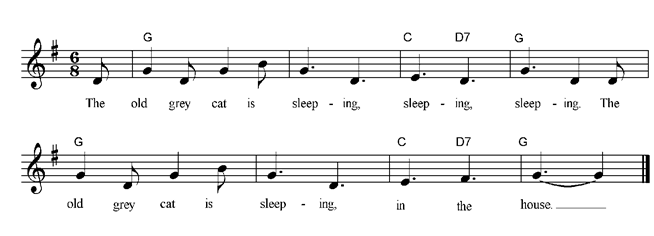
|
The old grey cat is sleeping, sleeping, sleeping. The old grey cat is sleeping in the house. The little mice come creeping, creeping, creeping. The little mice come creeping in the house. The little mice are nibbling, nibbling, nibbling. The little mice are nibbling in the house. The little mice are sleeping … in the house. The old grey cat comes creeping … in the house. The little mice all scamper … through the house. The little mice are hiding … in the house. |
|
How often are children’s clothes mended today? This simple
game however continues to give pleasure in the playground. Children hold hands
in a line; the end person is the knot and makes an arch with the child next
to them. The needle at the head of the line walks the others through the arch
and back to its original position so the last person to go under will find
their arms now crossed. The game continues with the needle threading through
subsequent arches until all children have arms crossed. The two end children
then join hands to make a circle and walk round for one final verse. |
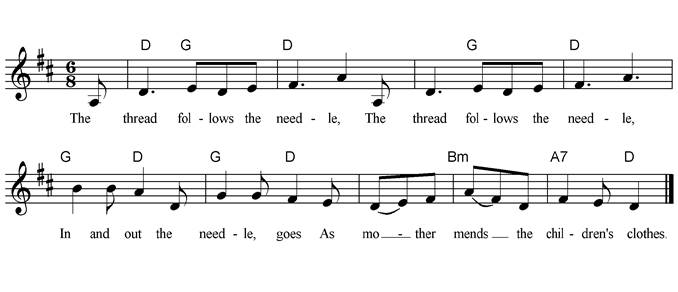
|
The thread
follows the needle, The thread
follows the needle, In and out
the needle goes As mother
mends the children’s clothes. |
|
There’s a dragon crawling
round 🔊 In West Java children play the dragon game below. It is
said this is a traditional Indonesian folk song but the tune does not sound
as if it comes from that geographical region! I would love to hear the
original in tis native language! Stand in a line
holding the waist of the child in front; the head of the dragon tries to
catch the tail but as the leader runs each child must hang on so the dragon
doesn’t break. If the head catches the tail the tail is out of the game. The
game resumes with a new head and tail. |

|
There's a
dragon crawling round, crawling round the room. Do not get
too close or it will surely spell your doom. A dragon's
always looking for something to munch; If you
don't watch out, you may be its lunch! |
|
This little hen 🔊 A farmyard follow my leader action
rhyme. A zipper song, add different animals and ways to move. From B.B.C. Radio Oxford, “Sing a
song of Sixpence” published in 1974. Music added by Dany Rosevear. 1. Walk on toes with elbows
flapping. 2. Walk with toes turned in and elbows flapping 3. Jump with hands
together in front. |
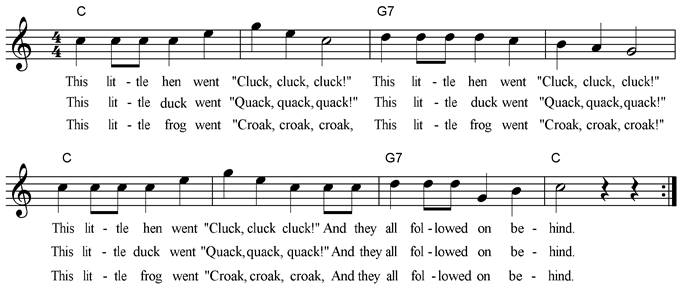
|
This
little hen went, “Cluck, cluck, cluck!” This
little hen went, “Cluck, cluck, cluck!” This
little hen went, “Cluck, cluck, cluck!” And they
all followed on behind. This
little duck went, “Quack, quack, quack!” This
little duck went, “Quack, quack, quack!” This
little duck went, “Quack, quack, quack!” And they
all followed on behind. This
little frog went, “Croak, croak, croak!” This
little frog went, “Croak, croak, croak!” This
little frog went, “Croak, croak, croak!” And they
all followed on behind. |
|
Turn, cinnamon, turn O A Florida singing game. This can be played as a Virginia
reel as below for verse one, as a circle game or simply to skip round the
room find a partner and swing them around on the last line. It could also be
used as a baby bouncing game! Make two lines facing
a partner. The two at the top hold hands and skip sideways down to the bottom
of the line. They then face each line then travel up the line right then left
hand in succession swinging each child and themselves to the top. Then skip
outside down to the bottom and holding hands with their original partner
swing them round as the rest of the line do the same. The game continues with
the next pair at the top. |
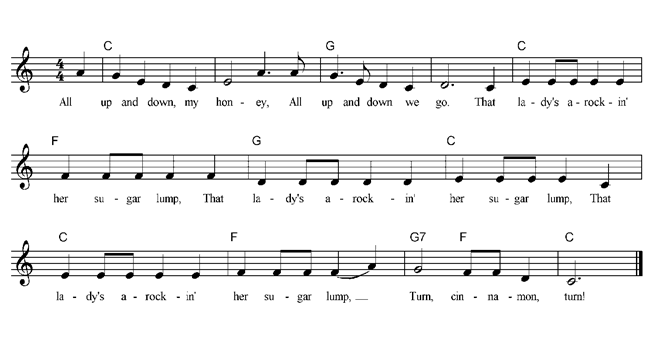
|
All up and down my honey, All up and down we go. That lady’s a-rockin’ her sugar lump, That lady’s a-rockin’ her sugar lump, That lady’s a-rockin’ her sugar lump, Turn, cinnamon, turn. All up and down my honey, All up and down we go, That grandma’s a-rockin’ her sweetie pie… Turn that cinnamon round and round, Turn that cinnamon round and round, Turn that cinnamon round and round, Turn that cinnamon round! She's my sugar-lump, I'll never give her up, She's my sugar-lump,
I'll never give her up, Turn that cinnamon round! All up and down my honey, All up and down we go, Brother’s a-rocking his sugar plum… All round the ring we go! |
|
Walking through the forest 🔊 Scared – not me! A
follow my leader game Out for an
adventurous walk and making some new but very interesting friends on the way. Played in both the minor and major
keys to suggest something scary out there followed by a more cheerful
atmosphere. Words and music by Dany Rosevear. Each time walk in lines of 5 or 6
taking turns to be the leader. Move around the room furtively with hand to
forehead looking from side to side weaving in and out and giving other groups
plenty of room for the first two lines. The last child in each line is the
creature met who jumps out making an appropriate action after the initial
walk. 1st verse: Dance with
the leader. 2. Everyone opens and closes arms. 3. Everyone makes funny faces. 4. Everyone catches and
splats the flea then sits down. |
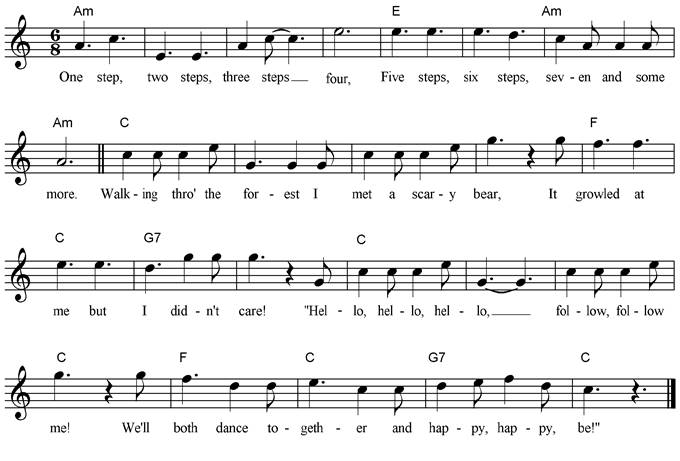
|
One step,
two steps, three steps, four, Five
steps, six steps, seven and some more. Walking
through the forest I met a scary bear, It growled
at me but I didn’t care! “Hello,
hello, hello, follow, follow me, We’ll both
dance together and happy, happy be.” One step,
two steps, three steps, four, Five
steps, six steps, seven and some more. Down by
the river I saw a crocodile, It snapped
at me so I gave my biggest smile! “Hello,
hello, hello, follow, follow me, We’ll all
snap together and happy, happy be!” One step,
two steps, three steps, four, Five
steps, six steps, seven and some more. Up in the
treetops a monkey scowled at me, It made a
cheeky face so I waved merrily! “Hello,
hello, hello, follow, follow me, We’ll make
faces together and happy, happy be!” One step,
two steps, three steps, four, Five steps,
six steps, seven and some more. Out in the
long grass I saw a tiny flea, It jumped
right up and it BIT ME! SPLAT! “Hello,
hello, hello, follow, follow me, Time for a
picnic lunch without that pesky flea!” |
|
We’re going on a bear hunt 🔊 A scary follow my leader game. This version of the traditional song is
from Michael Rosen’s 1989 children’s picture book of the same name. Can remember when the whole school did this in assembley. Push grass aside. Swim overarm. Squelch with clawed hands. Push
branches away. Swirl arms. Tiptoe with one finger. Touch nose, form ears and
eyes with thumbs and forefingers. |
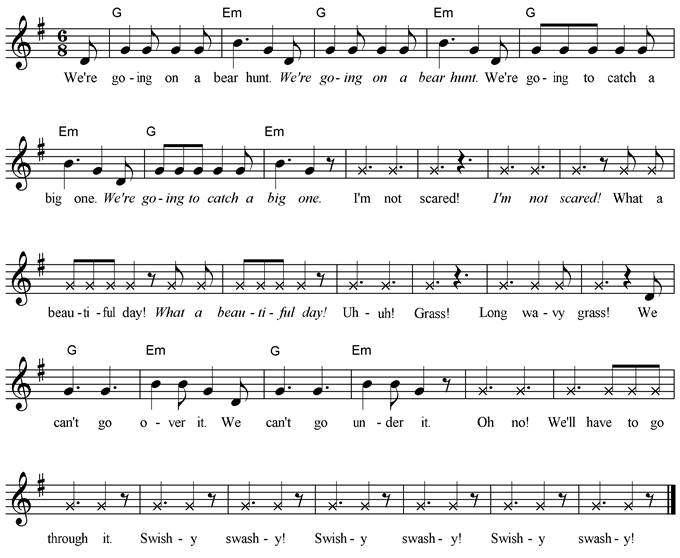
|
We’re going on a bear hunt We’re going on a bear hunt We’re going catch a big one, We’re going catch a big one, We’re not scared. We’re not scared. What a beautiful day! What a beautiful day! Uh-uh! Grass! Long wavy grass. We can't go over it. We can't go
under it. Oh no! We’ll have to go through it! Swishy swashy! Swishy swashy!
Swishy swashy! We’re going on a bear hunt We’re going on a bear hunt … What a beautiful day! What a beautiful day! Uh-uh! A river! A deep cold river. We can't go over it. We can't go under it. Oh no! We’ll have to go through it! Splash splosh! Splash splosh!
Splash splosh! We’re going on a bear hunt We’re going on a bear hunt … What a beautiful day! What a beautiful day! Uh-uh! Mud! Thick oozy mud. We can't go over it. We can't go under it. Oh no! We’ll have to go through it! Squelch squerch! Squelch squerch!
Squelch squerch! We’re going on a bear hunt We’re going on a bear hunt … What a beautiful day! What a beautiful day! Uh-uh! A forest! A big dark forest. We can't go over it. We can't go
under it. Oh no! We’ll have to go through it! Stumble trip! Stumble trip! Stumble
trip! We’re going on a bear hunt We’re going on a bear hunt … What a beautiful day! What a beautiful day! Uh-uh! A snowstorm! A swirling, whirling snowstorm. We can't go over it. We can't go under it. Oh no! We’ll have to go through it! Hooo whooo! Hooo whooo! Hooo whooo! We’re going on a bear hunt We’re going on a bear hunt … What a beautiful day! What a beautiful day! Uh-uh! A cave! A narrow gloomy cave. We can't go over it. We can't go under it. Oh no! We’ll have to go
through it! Tiptoe! Tiptoe! Tiptoe! WHAT’S THAT! One shiny wet nose! Two big furry ears! Two big goggly eyes! IT’S A
BEAR! Quick! Back through the cave! Tiptoe! Tiptoe! Tiptoe! Back through the snowstorm! Hooo whooo! Hooo whooo! Hooo whooo! Back through the forest! Stumble trip! Stumble trip! Stumble trip! Back through the mud! Squelch squerch! Squelch squerch! Squelch
squerch! Back through the river! Splash splosh! Splash splosh! Splash splosh! Back through the grass! Swishy swashy! Swishy swashy! Swishy swashy! Get to our
front door! Up the stairs. Oh no! We forgot
to shut the door, Back downstairs, shut the door! Back upstairs. Into the
bedroom, Into bed, Under the covers. We’re not going on a bear hunt again! |
|
In the past children watched their mothers spin wool to
weave into clothe which might have suggested this game. Look at different
types of bobbins and how they have been used in the past. Children hold hands
in a line; one person, the tail stands still as the child at the other end
leads the line round repeating the first phrase until a fairly tight spiral
is formed. Lift hands up and wave to the second part. On ‘Break it!’ drop
hands and scatter. |
![]()
|
Wind the
bobbin, “Ding dang,” Gonna wind
it tight, “Ding dang.” Wind the
bobbin, “Ding dang,” Gonna wind
it tight, “Ding dang.” Bobbin
a-wound up, bobbin a-wound up, Bobbin a-wound up, BREAK IT! |
|
Wind up the apple tree 🔊 A game that can be played at apple tree wassails on the Eve
of Old Christmas or Twelfth Night ideally outside with a real apple tree! This is from the Kentucky Dance Institute pamphlet
published in 1960. It also features in Lady Gomme’s book. 1. Children stand in
a single curved line with hands joined. The child at the left end is the
apple tree, and stands still, while the child at the other end is the leader
and leads the line round and round the tree. 2. When all are wound up the
leader runs straight out, which makes the tree turn round fast. |
![]()
|
1. Wind up
the apple tree, hold on tight. Wind all
day and wind all night. (Repeat as
many times as necessary) 2. Stir up
the dumplings, the pot boils over! x2 |
Return to the
‘Singing games for
children’ home page



